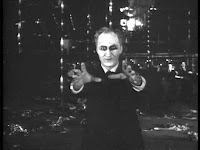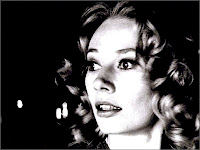As a supporter of the Classic Horror Campaign I've up dated this post. The beauty of black and white photography aside, today's black and white motion film is usually used as a nostalgic gimmick, with exceptions of the likes of Tim Burton's Ed Wood (1994). Apart from the obvious monster classics of the 30's and 40's there are countless black white (b/w) films regarded as 'classic'. Purists and b/w fans would probably have me locked up and flogged but I must admit I really do not think b/w necessary adds to the aesthetics of a film. I would argue that the feel and atmosphere can stir the same emotions in colour pallet. To sum it up in a sentence, we don't see life through our eyes in black and white.
Nevertheless, many great films were made in black and white and some of those were very influential horrors which I've commented on below. I hope you enjoy and possibly seek out if you not seen them already...
House on Haunted Hill (1959)
Allegedly rousing Alfred Hitchcock to make the horror film - Psycho (1960), and while the setting is not as lavish as The Haunting (1963) the House on Haunted Hill is an entertaining 50's movie.
%2520Vincent%2520Price%2520DVD%2520Review%2520PDVD_009.jpeg) Eccentric millionaire Fredrick Loren played wonderfully by Vincent Price invites 5 people to the house on Haunted Hill for a "haunted House" party and they'll get $10,000 if they survive the night. The quirky house owner, Mr. Pritchard is played entertainingly by Elisha Cook Jr. and the rest of the cast are good enough.
Eccentric millionaire Fredrick Loren played wonderfully by Vincent Price invites 5 people to the house on Haunted Hill for a "haunted House" party and they'll get $10,000 if they survive the night. The quirky house owner, Mr. Pritchard is played entertainingly by Elisha Cook Jr. and the rest of the cast are good enough.  Vincent Price is without a doubt the best thing about the film oozing charm, wit and panache. What is interesting and worthy of note is Robb White's adultery plot builds the tension and interaction between Price and Ohmart, reminiscent intensified versions of the characters in Hitchcock's Dial M for Murder (1954).
Vincent Price is without a doubt the best thing about the film oozing charm, wit and panache. What is interesting and worthy of note is Robb White's adultery plot builds the tension and interaction between Price and Ohmart, reminiscent intensified versions of the characters in Hitchcock's Dial M for Murder (1954). While the story 'twist' is well developed the large modern 50's house story is not. There are some creepy moments that include the striking Carol Ohmart as Annabelle Loren but the lighting and sets are so crisp it fails to create any real brooding atmosphere and sadly a movie of its time, the women shriek a lot.
While the story 'twist' is well developed the large modern 50's house story is not. There are some creepy moments that include the striking Carol Ohmart as Annabelle Loren but the lighting and sets are so crisp it fails to create any real brooding atmosphere and sadly a movie of its time, the women shriek a lot.Should the house itself has been more traditionally githic this may have been a near on perfect black and white chiller. Still, it's good fun and worth checking out on a quiet dark night if even just to hear Price's deep tones.

The Haunting (1963/I)
 Dr. Markway is undertaking research to prove the existence of ghosts and decides to investigate Hill House. He is accompanied by a sceptic, a clairvoyant and an insecure attuned psychic. Even though made in 1963 it is still very enjoyable even if a product of its time.
Dr. Markway is undertaking research to prove the existence of ghosts and decides to investigate Hill House. He is accompanied by a sceptic, a clairvoyant and an insecure attuned psychic. Even though made in 1963 it is still very enjoyable even if a product of its time.Nelson Gidding screenplay is based on novel "The Haunting of Hill House" by Shirley Jackson. The Haunting is an archetype haunted mansion film, superbly directed by Robert Wise. Excellent, painstakingly designed sets, amazing use of sound effects bringing to life the things that go bump in the night, which all add to the eerie and spooky atmosphere.
 Richard Johnson plays the perfect English gentleman, Dr. John Markway. Russ Tamblyn as the cheeky chap is amusing, Claire Bloom is 'Theo' the lesbian, at the time a risky role for mainstream cinema. The rest of the supporting cast of quirky characters are all fantastic.
Richard Johnson plays the perfect English gentleman, Dr. John Markway. Russ Tamblyn as the cheeky chap is amusing, Claire Bloom is 'Theo' the lesbian, at the time a risky role for mainstream cinema. The rest of the supporting cast of quirky characters are all fantastic. My only complaints are that the movie, for effect only, was unnecessary filmed in black and white. In addition, Julie Harris' superfluous voice-overs are distracting.
My only complaints are that the movie, for effect only, was unnecessary filmed in black and white. In addition, Julie Harris' superfluous voice-overs are distracting.It's exceedingly atmospheric, foreboding, creepy and while the scares and terror are not as frightening to today's audience, it remains a classic, psychological, genuine and suspenseful horror.

Night of the Living Dead (1968)
 George A. Romero has readily admitted that Herk Harvey's Carnival of Souls influenced in his making of Night Of The Living Dead (NOTLD). For me, they're both low budget, both filmed in black and white and both are chilling creepy in places.
George A. Romero has readily admitted that Herk Harvey's Carnival of Souls influenced in his making of Night Of The Living Dead (NOTLD). For me, they're both low budget, both filmed in black and white and both are chilling creepy in places.Both went onto be get 'lost' but unlike Carnival of Souls, NOTLD was haled by critics abroad, who saw it not just as another horror movie, but a film that reflects society. Romero has gone on to define a genre, a feat that very few have accomplished. Many films have been influenced and have imitated George's creation but few successfully.
NOLD is seeped in history and has become as intriguing as the chiller its self. There's really not too much to comment on that hasn't already been said before. The dead are played mindlessly well. Duane Jones is a fantastic lead actor and stands out, an actor ahead of his time but the others are less convincing.
 The stock music is bold, and the sound is an adequate mix but all these things with their faults add to the charm of this little horror classic.
The stock music is bold, and the sound is an adequate mix but all these things with their faults add to the charm of this little horror classic.
It's dark, gloomy and entertaining but more importantly it was a turning point in horror history.

Carnival of Souls (1962)
 The stock music is bold, and the sound is an adequate mix but all these things with their faults add to the charm of this little horror classic.
The stock music is bold, and the sound is an adequate mix but all these things with their faults add to the charm of this little horror classic.It's dark, gloomy and entertaining but more importantly it was a turning point in horror history.

Carnival of Souls (1962)
 A true horror classic Director Herk Harvey and writer John Clifford both waived their earnings in order to get the film made. Upon release in 1962 the film was a failure in the box office, thankfully its subsequent airings on late night television helped to gain it a strong cult following so Clifford and Herks work was not all in vain.
A true horror classic Director Herk Harvey and writer John Clifford both waived their earnings in order to get the film made. Upon release in 1962 the film was a failure in the box office, thankfully its subsequent airings on late night television helped to gain it a strong cult following so Clifford and Herks work was not all in vain.The delightful Candace Hilligoss is perfectly cast as the troubled woman that after surviving a traumatic car accident, that kills her two friends, becomes haunted by a frightening ghoul and drawn to a mysterious abandoned carnival. It's a shame that Hilligoss only acted in two features as she gives an impressive performance as Mary Henry.

The music is very creepy and a little too intrusive in places, however, for it's time and budget it is a well crafted film. Carnival of Souls many not be as sleek and stylish as the Haunting (1963) but it is far more eerie. The zombies are not as imposing as in Night of the Living Dead, however, they are vastly creepier and macabre.

 Oozing atmosphere it's a creative and unnerving film that concludes with a common place twist but back in '62 it was ahead of it's time, a true cult classic.
Oozing atmosphere it's a creative and unnerving film that concludes with a common place twist but back in '62 it was ahead of it's time, a true cult classic.  The Last Man on Earth (1964)
The Last Man on Earth (1964)The tag-line read 'By night they leave their graves, crawling, shambling, through empty streets, whimpering, pleading, begging for his blood' if that doesn't grab you as a horror fan, nothing will. Remade many times since as The Omega Man (1971), I am Legend (2007) to name a few, Richard Matheson novel I am Legend has been a wealthy piece of source material.
 Despite Matheson feeling that Vincent Price was miscast in the lead role, Price gives a sterling performance as Dr. Robert Morgan who is the survivor of a devastating world-wide plague. Morgan is tortured by his dreams and his solitary existence trying to find another human still alive. Price's distinguished voice and acting really gets the viewer hooked and caring for his character who is harassed by vampire zombies seeking his blood every night.
Despite Matheson feeling that Vincent Price was miscast in the lead role, Price gives a sterling performance as Dr. Robert Morgan who is the survivor of a devastating world-wide plague. Morgan is tortured by his dreams and his solitary existence trying to find another human still alive. Price's distinguished voice and acting really gets the viewer hooked and caring for his character who is harassed by vampire zombies seeking his blood every night.While not a faithful version of the novel it is well crafted by Ubaldo Ragona, who incidentally only directed a handful of films. Ragona's work clearly influenced Romero's set up of the horror classic Night of the living Dead (1968).

 Admittedly The Last Man on Earth is slow in places and the music by Paul Sawtell and Bert Shefter is bland and of it's time. Nevertheless, the locations are great featuring, bleak backdrops and curious architecture which leaves the viewer disconcerted.
Admittedly The Last Man on Earth is slow in places and the music by Paul Sawtell and Bert Shefter is bland and of it's time. Nevertheless, the locations are great featuring, bleak backdrops and curious architecture which leaves the viewer disconcerted. What this unsung black and white chiller gem demonstrates best is that The Last Man on Earth shows what a fascinating and captivating actor Vincent Price was.



No comments:
Post a Comment